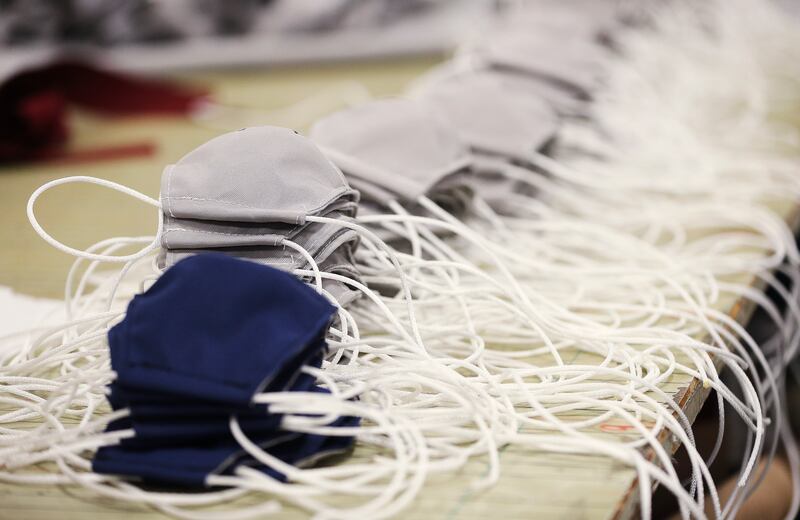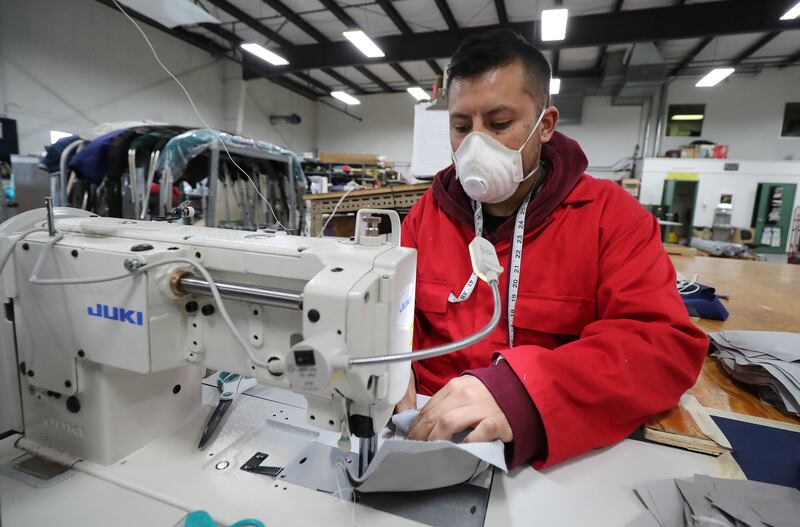SALT LAKE CITY — The White House is expected to soon urge people to begin wearing cloth face masks in order to slow the spread of COVID-19 in a public health about-face.
The Washington Post said sources had confirmed the advice reversal that would recommend wearing cloth masks, not medical-grade, based on “internal memos and new guidance provided to the White House by the CDC.”
A month ago, the World Health Organization and the Centers for Disease Control and Prevention stated flatly the public wouldn’t benefit from face masks. Masks, they said, should be reserved for health care providers and for those who are sick and their immediate caregivers, but offer little benefit for others.
They still say medical-grade masks must be available to protect those providing direct care to COVID-19 patients and those who do testing. But their advice to the public is shifting — in terms of nonmedical-quality face masks — in light of evidence suggesting that one-fourth of those infected don’t show symptoms.
“This helps explain how rapidly this virus continues to spread across the country,” CDC director Dr. Robert Redfield told National Public Radio.
Even U.S. Surgeon Gen. Jerome Adams seems to be backing off from his now-viral tweet of Feb. 29: “Seriously people — STOP BUYING MASKS! They are NOT effective in preventing general public from catching coronavirus, but if healthcare providers can’t get them to care for sick patients, it puts them and our communities at risk!”
Wednesday, he told NBC’s “Today” show that he’s asked the CDC to investigate whether the recommendation should change, according to CNBC. “He explained the advice to avoid wearing masks had been based on the ‘best available evidence at the time,’ but ‘we now know there is a significant amount of asymptomatic spread.’”
Dr. Anthony Fauci, the nation’s most familiar voice on this coronavirus, said he’s leaning toward recommending the public wear masks “if we do not have the problem of taking away masks from the health care workers who need them.”
Community-wide mask use “outside of the health care setting is under very active discussion at the task force. The CDC group is looking at that very carefully,” Fauci, longtime director of the National Institute of Allergy and Infectious Diseases, told CNN.
WHO also signaled this week that change may be coming.
According to The Guardian, “Speaking at a Chatham House briefing on Wednesday, Prof. David Heymann, an infectious disease expert who led the global response to the SARS outbreak, said that new evidence from Hong Kong had prompted a reconsideration of the role of face masks. ‘The WHO is debating that tomorrow to understand if there is evidence that would call for a change in what WHO is recommending.’”
Media have circled the questions for days.
“Should we all be wearing masks?” asked The Washington Post, which said the CDC review comes as a “grassroots pro-mask movement” takes hold. “But there’s still no consensus on whether widespread use of facial coverings would make a significant difference, and some infectious disease experts worry that masks could lull people into a false sense of security and make them less disciplined about social distancing.”
The article cited an unnamed CDC official who said the organization may alter guidance to encourage people to cover their faces. That recommendation would not include surgical and N95 masks needed by medical workers. “Instead, the recommendation under consideration calls for using do-it-yourself cloth coverings.”

What kind of mask?
On Monday, Dr. Mike Ryan, executive director of the WHO health emergencies program, told reporters, “There is no specific evidence to suggest that the wearing of masks by the mass population has any potential benefit. In fact, there’s some evidence to suggest the opposite in the misuse of wearing a mask properly or fitting it properly.”
”There also is the issue that we have a massive global shortage,” Ryan said about masks and other medical supplies. “Right now the people most at risk from this virus are front-line health workers who are exposed to the virus every second of every day. The thought of them not having masks is horrific.”
The director of the Johns Hopkins Center for Health Security, Thomas Inglesby, told the Post that homemade coverings aren’t perfect and shouldn’t make people stop staying at least six feet apart, but they might reduce transmission of the virus.
Scott Gottlieb, former FDA commissioner and resident fellow at the American Enterprise Institute, wrote in that agency’s pandemic response plan that everyone should wear “nonmedical fabric masks” in public, whether they have symptoms or not.
No one claims fabric masks protect the wearer from infection. Their utility, proponents say, is limiting the wearer’s respiratory secretions, which might infect others.
Both CDC and WHO have warned that masks pose risk of infection if they’re not handled properly, cleaned well or thrown away carefully. They worry people will rely on the mask and get sloppy about social distancing and hand-washing, which experts agree are the most effective strategies to stop disease spread.
The view from elsewhere
Other countries have long taken a different approach to face masks.
Time reports that masks have been worn for many years in different Asian countries for reasons from keeping a face warm to protecting the wearer and others from an illness to simple fashion.
“The shadow of SARS 17 years ago also helps to explain the prevalence of masks, especially in Hong Kong,” the article said.
“It was largely the shock of SARS that shaped this local etiquette,” Ria Sinha, a research fellow at the University of Hong Kong’s Center for the Humanities and Medicine, told Time. “Although the younger generation do not remember SARS, their parents and grandparents did experience the fear and uncertainty of a novel infectious disease, and the loss of daily normality.”
She called wearing a mask a “symbol and a tool of protection and solidarity” whether research says they’re effective or not, “bound up in sociocultural practice.”
An international panel in the journal The Lancet said the novel coronavirus arrival has made use of masks “ubiquitous in China and other Asian countries such as South Korea and Japan.”
In Hong Kong people are advised to wear a surgical mask on public transport or in crowds. In China, people are advised to wear a mask in public places. Japan notes the ability of a face mask to avoid viral infection is “thought to be limited,” but the mask could help in “confined, badly ventilated spaces.” The United Kingdom and Germany both see little benefit from masks for healthy people to avoid virus spread.
The report concluded that mask use could be helpful during this contagion, noting “an essential distinction between absence of evidence and evidence of absence. Evidence that face masks can provide effective protection against respiratory infections in the community is scarce, as acknowledged in recommendations from the UK and Germany. However, face masks are widely used by medical workers as part of droplet precautions when caring for patients with respiratory infections.”
The group found it “reasonable to suggest vulnerable individuals avoid crowded areas and use surgical face masks rationally when exposed to high-risk areas. As evidence suggests COVID-19 could be transmitted before symptom onset, community transmission might be reduced if everyone, including people who have been infected but are asymptomatic and contagious, wear face masks.”
The count
By Thursday afternoon, 1,011,490 people worldwide had lab-confirmed COVID-19 and 52,863 had died, according Johns Hopkins University, which is keeping a running tally. The novel coronavirus has reached 181 countries. In the United States, 242,182 people have been diagnosed with COVID-19 and 5,850 have died.
Seven people in Utah have died from complications of the infection. According to the Utah Department of Health, at least 1,074 have been infected, more than 21,065 have been tested and 100 individuals required hospitalization.
For guidance on getting tested, symptoms, how to clean, caring for someone who is ill and more, check out the Deseret News coronavirus survival guide.


